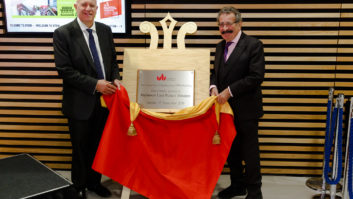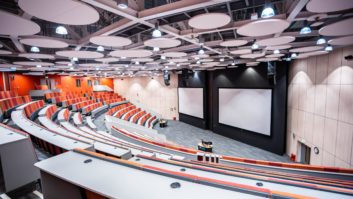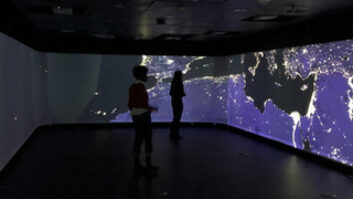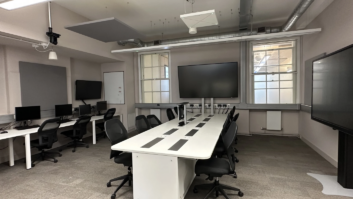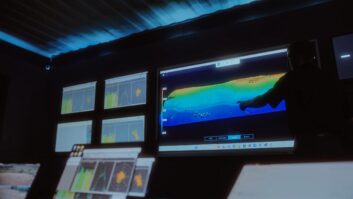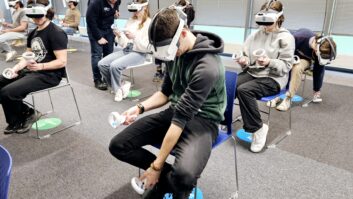The main brief for project integrator Hereworks was to embrace new technologies, integrating them into cutting edge solutions which make buildings and campuses more efficient, more user friendly and more reliable.
Dublin City University (DCU) identified a need to update its digital technology infrastructure to facilitate the university’s progression to a more collaborative and flipped learning classroom environment to enable its staff to communicate more efficiently across campuses and with its 1,500-plus distance learning students worldwide.
The university has recently undergone a huge investment in carrying out a digital transformation across its campuses in order to improve its teaching facilities, continuously investing in AV technology as a means of delivering information to students more effectively.
The digital upgrade involved the integration of a whole new array of intuitive communication and collaboration technologies such as lecture theatre AV equipment, control panels and digital signage. As part of the upgrade, the university installed the latest Panasonic laser projection technology, alongside the Crestron Digital Media Platform within each suitable teaching space across the campus.
The investment initially included the Panasonic PT-RW300 laser projector for seminar rooms, along with the PT-RW630 which was chosen for the larger lecture theatres. Having created a blueprint for the university’s digital future, the technology was rolled out across the Glasnevin campus, taking the total number of projectors to more than 180 across 22 buildings.
In 2019, the university furthered its investment with Panasonic projection in the Stokes Annex Building. The purpose of the project was to create a state-of-the-art teaching facility around the idea of a flipped classroom, where students do a lot of their learning outside of formal lessons, and the classroom becomes much more of a collaborative space.
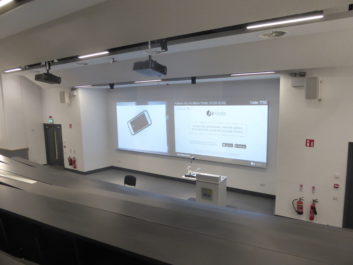 The project included two large auditoriums, six lecture rooms and a hybrid classroom which provided a collaborative space for blended learning; this room layout was designed with three projectors whereby the third screen displays the remote participants. The university wanted to provide the ability for students to communicate more efficiently from remote locations and the hybrid classroom design made the four walls of the classroom disappear.
The project included two large auditoriums, six lecture rooms and a hybrid classroom which provided a collaborative space for blended learning; this room layout was designed with three projectors whereby the third screen displays the remote participants. The university wanted to provide the ability for students to communicate more efficiently from remote locations and the hybrid classroom design made the four walls of the classroom disappear.
The same Crestron touch user interface screen was applied across the whole campus and the standard classrooms used dual projection Panasonic PTR-RZ570 5K projectors, while the larger auditoriums utilised the Panasonic PT-RZ970 10K projectors.
Each room allows students to collaborate with their own device using Crestron Airmedia. Hereworks installed PTZ cameras for lecture capture and document cameras. Room Audio included Shure ceiling microphones, Crestron speakers and a PA system. Rooms were enabled with Zoom video conferencing and all devices were integrated with the Crestron Fusion monitoring system.
- Pure AV install for Bedfordshire University
- Western Australia Academy for Performing Arts goes wireless with Riedel’s Bolero
- Renkus Heinz steers-in new audio for New York University School of Law refurb
Testimonial
Videoconferencing is part of DCU’s sustainability plan to reduce its overall carbon footprint. The blended learning room and lecture halls solutions introduced a revenue stream for the university which allows it to educate increased numbers of overseas students more effectively.
“DCU’s commitment to develop a 21st century digital campus requires a partner that can reliably bring leading edge, best in class solutions to realise this. Panasonic & Hereworks have been the perfect fit,” said Barbara McConologue, director of information system services at Dublin City University.
Hereworks CEO Tomás Mac Eoin added, “The client brief was based on the idea of a flipped classroom, where students do a lot of their learning outside of formal lessons, and the classroom becomes much more of a collaborative space. It’s very important in that context that both lecturers and students can bring digital materials in to that space and the technology helps ensure it works. We arranged a shootout for DCU involving Panasonic laser projectors against some rivals and the results just blew them away.
“Our imagination is the only limit to what we can do with do with our technology,” he concluded. “Overcoming our clients’ challenges is our primary goal. Proudly, our innovation team designed one of the world’s first practical systems of gesture controls in collaboration with Dr. Donal Fitzpatrick, a lecturer who happens to be blind, and who works in the School of Computing DCU, making touchscreens accessible to the visually impaired.”
